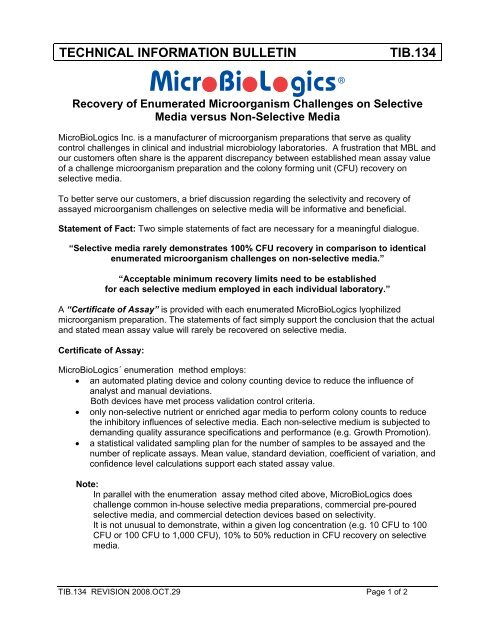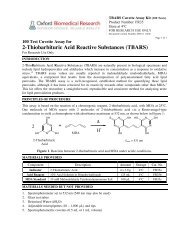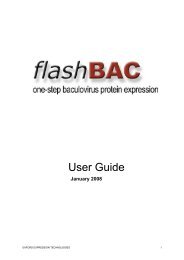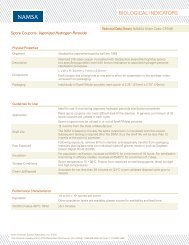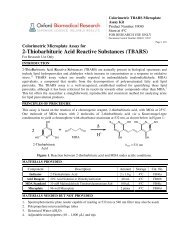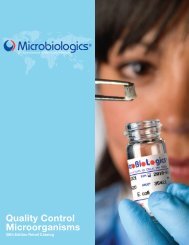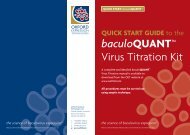technical information bulletin tib.134 - BioNovus Life Sciences
technical information bulletin tib.134 - BioNovus Life Sciences
technical information bulletin tib.134 - BioNovus Life Sciences
Create successful ePaper yourself
Turn your PDF publications into a flip-book with our unique Google optimized e-Paper software.
TECHNICAL INFORMATION BULLETIN TIB.134<br />
Recovery of Enumerated Microorganism Challenges on Selective<br />
Media versus Non-Selective Media<br />
MicroBioLogics Inc. is a manufacturer of microorganism preparations that serve as quality<br />
control challenges in clinical and industrial microbiology laboratories. A frustration that MBL and<br />
our customers often share is the apparent discrepancy between established mean assay value<br />
of a challenge microorganism preparation and the colony forming unit (CFU) recovery on<br />
selective media.<br />
To better serve our customers, a brief discussion regarding the selectivity and recovery of<br />
assayed microorganism challenges on selective media will be informative and beneficial.<br />
Statement of Fact: Two simple statements of fact are necessary for a meaningful dialogue.<br />
“Selective media rarely demonstrates 100% CFU recovery in comparison to identical<br />
enumerated microorganism challenges on non-selective media.”<br />
“Acceptable minimum recovery limits need to be established<br />
for each selective medium employed in each individual laboratory.”<br />
A “Certificate of Assay” is provided with each enumerated MicroBioLogics lyophilized<br />
microorganism preparation. The statements of fact simply support the conclusion that the actual<br />
and stated mean assay value will rarely be recovered on selective media.<br />
Certificate of Assay:<br />
MicroBioLogics´ enumeration method employs:<br />
• an automated plating device and colony counting device to reduce the influence of<br />
analyst and manual deviations.<br />
Both devices have met process validation control criteria.<br />
• only non-selective nutrient or enriched agar media to perform colony counts to reduce<br />
the inhibitory influences of selective media. Each non-selective medium is subjected to<br />
demanding quality assurance specifications and performance (e.g. Growth Promotion).<br />
• a statistical validated sampling plan for the number of samples to be assayed and the<br />
number of replicate assays. Mean value, standard deviation, coefficient of variation, and<br />
confidence level calculations support each stated assay value.<br />
Note:<br />
In parallel with the enumeration assay method cited above, MicroBioLogics does<br />
challenge common in-house selective media preparations, commercial pre-poured<br />
selective media, and commercial detection devices based on selectivity.<br />
It is not unusual to demonstrate, within a given log concentration (e.g. 10 CFU to 100<br />
CFU or 100 CFU to 1,000 CFU), 10% to 50% reduction in CFU recovery on selective<br />
media.<br />
TIB.134 REVISION 2008.OCT.29 Page 1 of 2
TECHNICAL INFORMATION BULLETIN TIB.134<br />
Selectivity and Recovery:<br />
An important lesson can be learned. Each in-house selective media preparation, commercial<br />
pre-poured selective medium, or commercial detection device based on selectivity must be<br />
quality controlled. In addition to such specifications and performance as sterility, pH,<br />
positive and negative differential reaction and colony morphology, evaluation of selectivity and<br />
recovery properties must be established and documented.<br />
The following is a simple procedure that can be used to demonstrate the recovery of challenge<br />
microorganisms on selective media.<br />
1. Select reference stock cultures or working stock cultures, traceable to authentic reference<br />
cultures, which are appropriate to challenge the medium’s selective properties.<br />
2. Prepare dilutions of the challenge microorganism to achieve a challenge concentration of 100<br />
CFU.<br />
If a selective agar medium or device is used as a “pour plate”, 100 CFU per 1.0 mL is<br />
recommended.<br />
If a selective agar medium or device is used as a “streak or spread plate”, 100 CFU per 0.1 mL<br />
is recommended.<br />
3. Inoculate three selective agar media with 100 CFU challenge microorganism per 1.0 mL or 0.1<br />
mL.<br />
Inoculate three non-selective standard methods agar media with 100 CFU challenge<br />
microorganism per 1.0 mL or 0.1 mL.<br />
4. Incubate both sets of selective and non-selective media in accordance with the requirements for<br />
the selective medium.<br />
5. Following incubation, count and average the CFU for the selective and non-selective media.<br />
Calculate the average and divide the average value of the non-selective CFU recovery into the<br />
selective CFU recovery. Multiply the answer by 100 to determine the Percent Recovery.<br />
Precaution and Advisory:<br />
The fact that a selective medium may not demonstrate exact correlation with CFU recovery in<br />
comparison with a non-selective medium should not be interpreted as a quality assurance<br />
performance failure. The value of detecting a target microorganism in a mixed population may<br />
justify less than complete CFU recovery due to selective or inhibitory properties in a medium.<br />
Two important considerations must be addressed:<br />
1. Selectivity and Recovery<br />
Everyone must be aware of the fact that, by its composition or formula, a selective<br />
medium may demonstrate some degree of selectivity or inhibitory influence against the<br />
microorganism(s) for which it is designed.<br />
2. Acceptable Minimum Recovery Limits<br />
Each laboratory, based on the specific use of a selective medium, should establish the<br />
recovery limit. The performance from batch to batch of a selective medium can vary due<br />
to influences such as incorrect formula components, excessive heating or sterilization,<br />
and microbiology suitability of the water. This consideration is important so reliable<br />
results are obtained in a reproducible manner.<br />
TIB.134 REVISION 2008.OCT.29 Page 2 of 2


